2024 Polestar 2 Review and Test Drive
Polestar updates its compact EV just in time to face an onslaught of new competitors.
 Christian Wardlaw
Christian Wardlaw
A decade ago, Polestar was a Swedish performance tuner specializing in Volvos. Today, it's an electric vehicle (EV) company headquartered in Sweden.
The story of how this came to be comes down to corporate acquisitions. Zhejiang Geely Auto Group bought Volvo from Ford in 2010. Volvo bought Polestar in 2015. Polestar became an electrified-vehicle brand by 2020. Polestars are designed and engineered in Sweden and manufactured in China.
So, if you're wondering why the Polestar 2 looks so much like a Volvo, now you know. The Polestar 2 is a compact sportback similar to the BMW i4, its closest rival. It went on sale in 2021, and for 2024, the Polestar 2 receives significant changes.
Aside from a front Smart Zone panel that replaces the grille, the Polestar 2 looks much like previous versions. The changes are underneath the bodywork, where the car offers new electric motors and battery packs, revised drivetrain configurations, and more power and driving range. In addition, Polestar claims the 2's carbon footprint is lower than before, and there is a new flexible leasing program to make the EV more appealing to consumers.
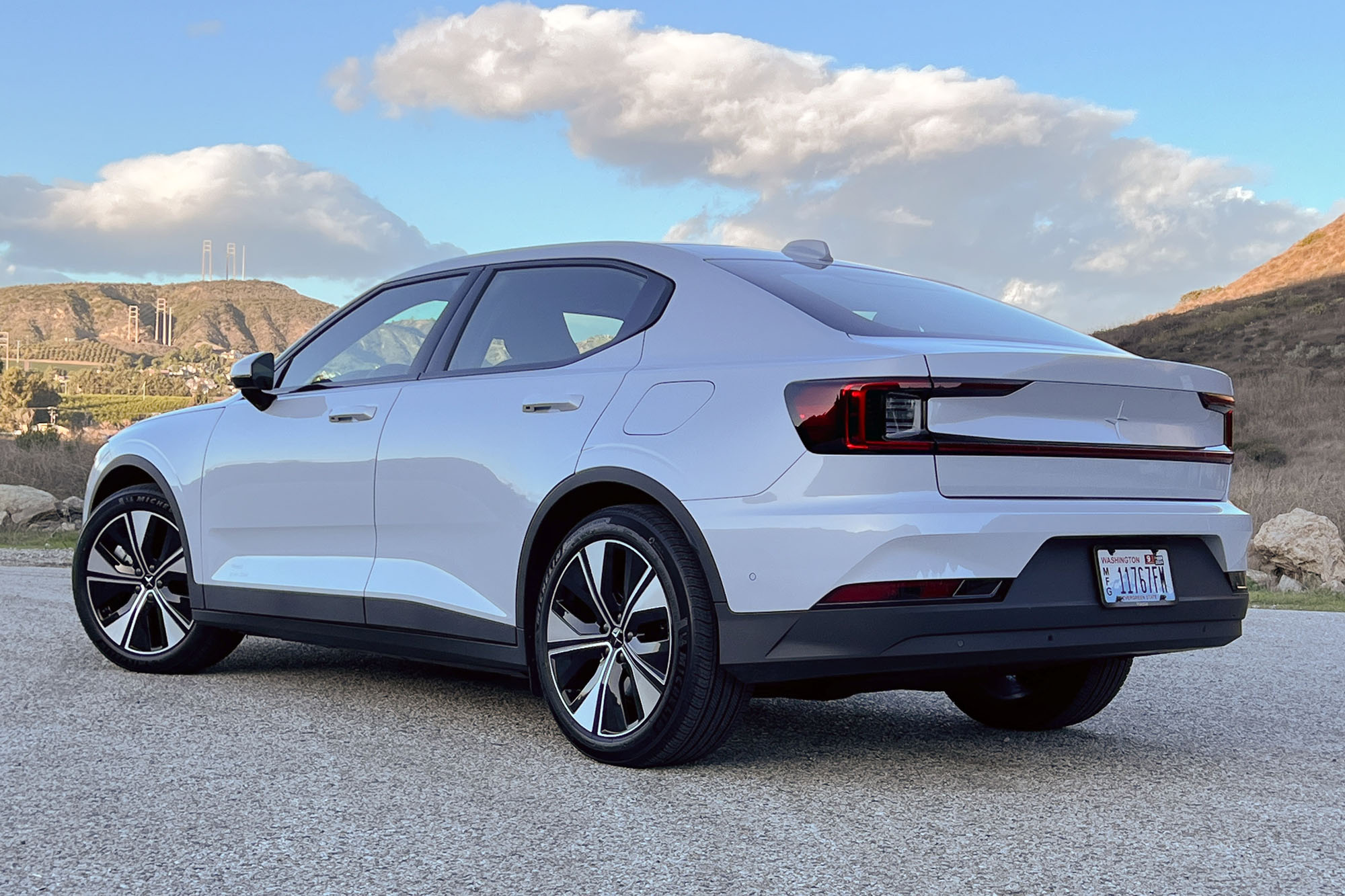 Christian Wardlaw
Christian Wardlaw
2024 Polestar 2 Prices Seek a Sweet Spot Regarding Value
The 2024 Polestar 2 comes in Long Range Single Motor and Long Range Dual Motor configurations, and base prices range from the low $50,000s to the mid-$50,000s, including the destination charge to ship the car from the Luqiao, China, factory that builds it to your local dealership.
The Polestar 2 is ineligible for an EV federal income tax credit. Still, Polestar offers its own $8,500 Clean Vehicle credit to customers with good credit who lease a brand-new one. In addition, a new flexible lease program gives you month-to-month flexibility after five months and five completed payments.
For this Polestar 2 review, I test-drove the Long Range Single Motor in Southern California. It had extra-cost Snow White metallic paint, the Plus Pack, and the Pilot Pack. Those options brought the manufacturer's suggested retail price to $56,750, including the $1,400 destination charge. Polestar provided the vehicle for this review.
 Christian Wardlaw
Christian Wardlaw
Scandinavian Style, Sensibility, and Sustainability
The Polestar 2 might be made in China, but it adheres to the tenets of Scandinavian design, inside and out. Minimalism is the rule, and sustainability is the goal.
Channeling established Volvo styling cues, the Polestar 2 looks good on its standard 19- and available 20-inch wheels. The car has generous ground clearance, and the sportback design with folding rear seats provides some of the utility of an SUV.
Polestar says the interior is vegan and maximizes sustainability, so the materials might be different from what you expect at the price. Few surfaces are soft, and the test car's optional WeaveTech artificial leather seats felt that way.
I dislike the Polestar 2's center console design. It intrudes on legroom, lacks practical storage space, and locates one of the cupholders under the center armrest. In addition, the stereo volume knob is directly behind the gear selector, flanked by touch-sensing buttons for the hazard flashers and defroster, making it too easy to turn them on accidentally.
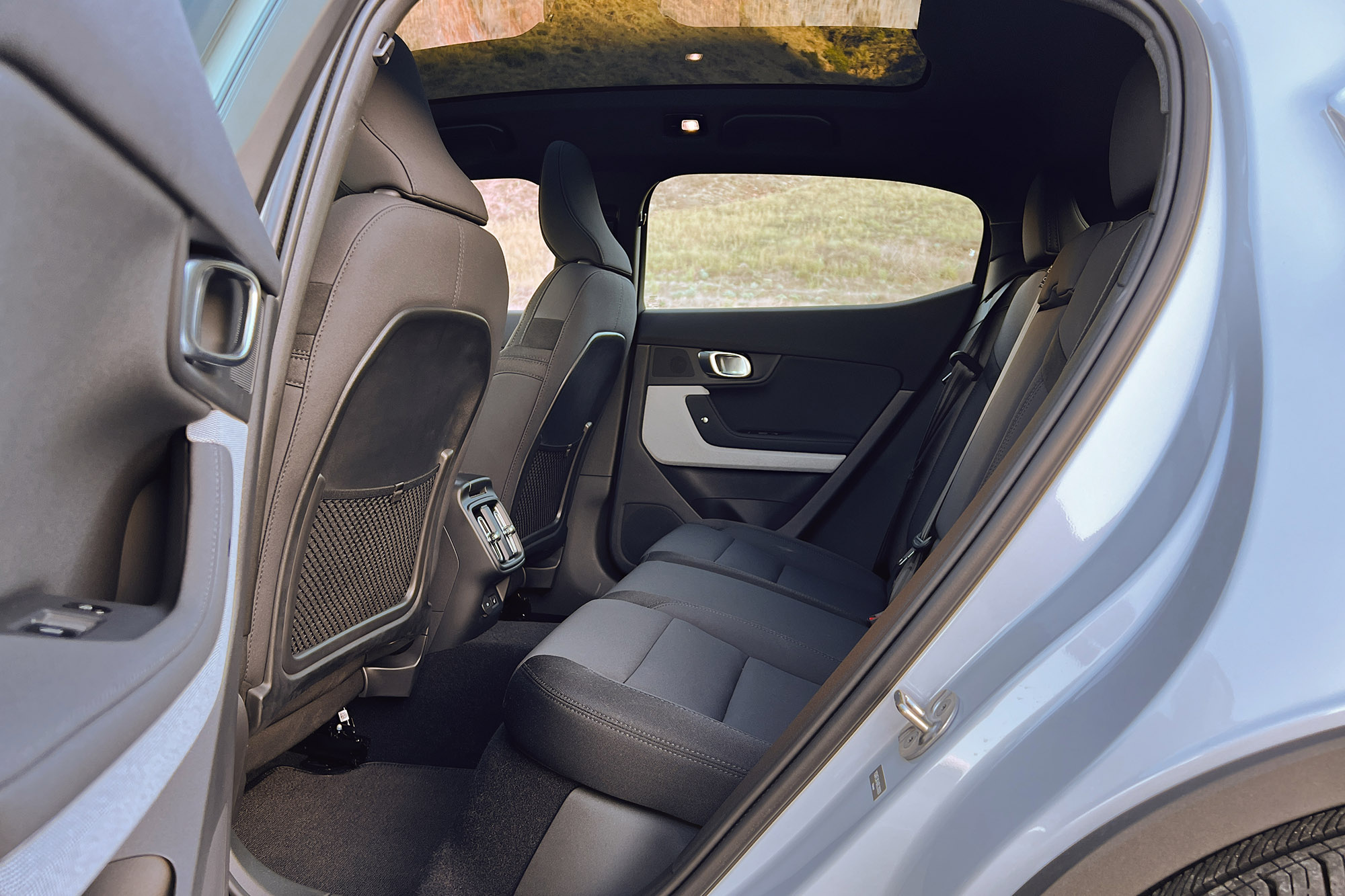 Christian Wardlaw
Christian Wardlaw
A Snug But Comfortable Fit
Thanks to its high ride height, getting into a Polestar 2 is easy. However, the sticky WeaveTech upholstery and the intrusive pillars complicate graceful exits from the car.
At first, I had trouble finding a comfortable seating position. I like to sit high in relation to the dashboard and door sills, but that's a challenge in the Polestar 2. The car's windows are short, and the roof is low. Outward visibility could be better, too. But, ultimately, I made my peace with it.
The heated front seats are comfortable, but that center console makes the Polestar 2 a snug fit. The back seat is more accommodating than expected, offering just enough legroom and headroom. My test car had standard rear air-conditioning vents and, as part of the Plus Pack, available heated rear seats.
In addition, the Plus Pack adds a heat pump and a heated steering wheel. The testing week was cold, and the heated seats and steering wheel came in handy because the heater didn't start cranking out warm air until I was nearly home after running my 10th grader to school.
 Christian Wardlaw
Christian Wardlaw
Good Utility, Deceptively Low Cargo Space Measurements
In addition to the Polestar 2's lack of practical in-cabin storage space, the cargo area is a little small. Open the power liftgate, and you'll find 14.4 cubic-feet of volume, including the compartment under the load floor. Maximum volume with the back seat folded down measures 38.7 cu-ft. Under the hood, a front trunk (frunk) adds another 1.2 cu-ft.
Note that Polestar measures cargo volume using the Verband der Automobilindutrie (VDA) method favored in Germany, not the Society of Automotive Engineers (SAE) method. The VDA method reflects how many 1-liter cargo blocks will fit in a given space, while the SAE method measures what a vehicle will carry if every nook and cranny has something stuffed into it.
 Christian Wardlaw
Christian Wardlaw
2024 Polestar 2's Google Built-in Infotainment System: Hey Google, You're Funny
Mounted in portrait orientation on the dashboard, the 11.2-inch touchscreen infotainment system is your portal to almost everything. It features Google built-in, including Google Maps, Google Assistant, and Google Play Store. But it also includes Apple CarPlay, Polestar Connect connected services, and satellite radio. My test car's Plus Pack equipped it with an excellent Harman Kardon premium audio system.
The Home screen features a customizable four-quadrant display, with access to the climate controls on a strip at the bottom. The system provides well-organized menus and seemingly endless ways to program Polestar 2 settings — you can also watch YouTube videos on the screen while waiting for the car to charge.
The Google Assistant voice recognition system works as expected and may even make you laugh. For example, when I told it I was too hot, instead of offering to adjust the climate system, it suggested that I go for a swim. In response to my list of testing commands, the tech performed well enough, though it sometimes required some fine-tuning on my part.
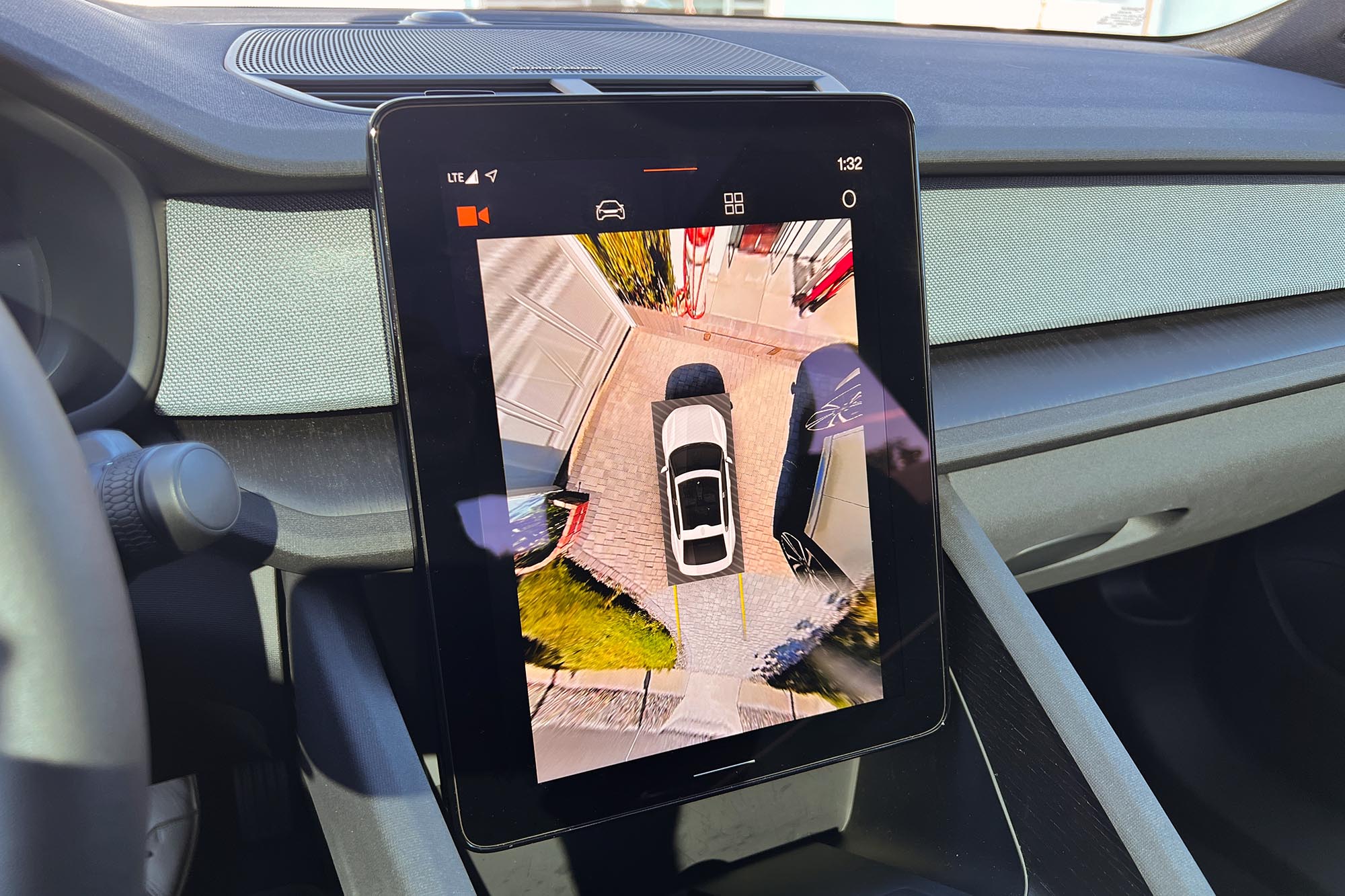 Christian Wardlaw
Christian Wardlaw
Distorting the Facts on the Ground
In addition to the infotainment screen, the Polestar 2 has a 12.3-inch digital instrumentation panel. It shows vehicle data, trip computer data, or a map display. You adjust the settings using the steering wheel controls.
My test vehicle also had parking sensors and a surround-view camera, which is especially helpful considering the poor outward visibility. Shift into reverse, and the default view is the reversing camera and rear parking sensor graphic. Touch the screen in the center, and the surround-view camera turns on. Unfortunately, the surroundings are so distorted I found it difficult to judge accurately.
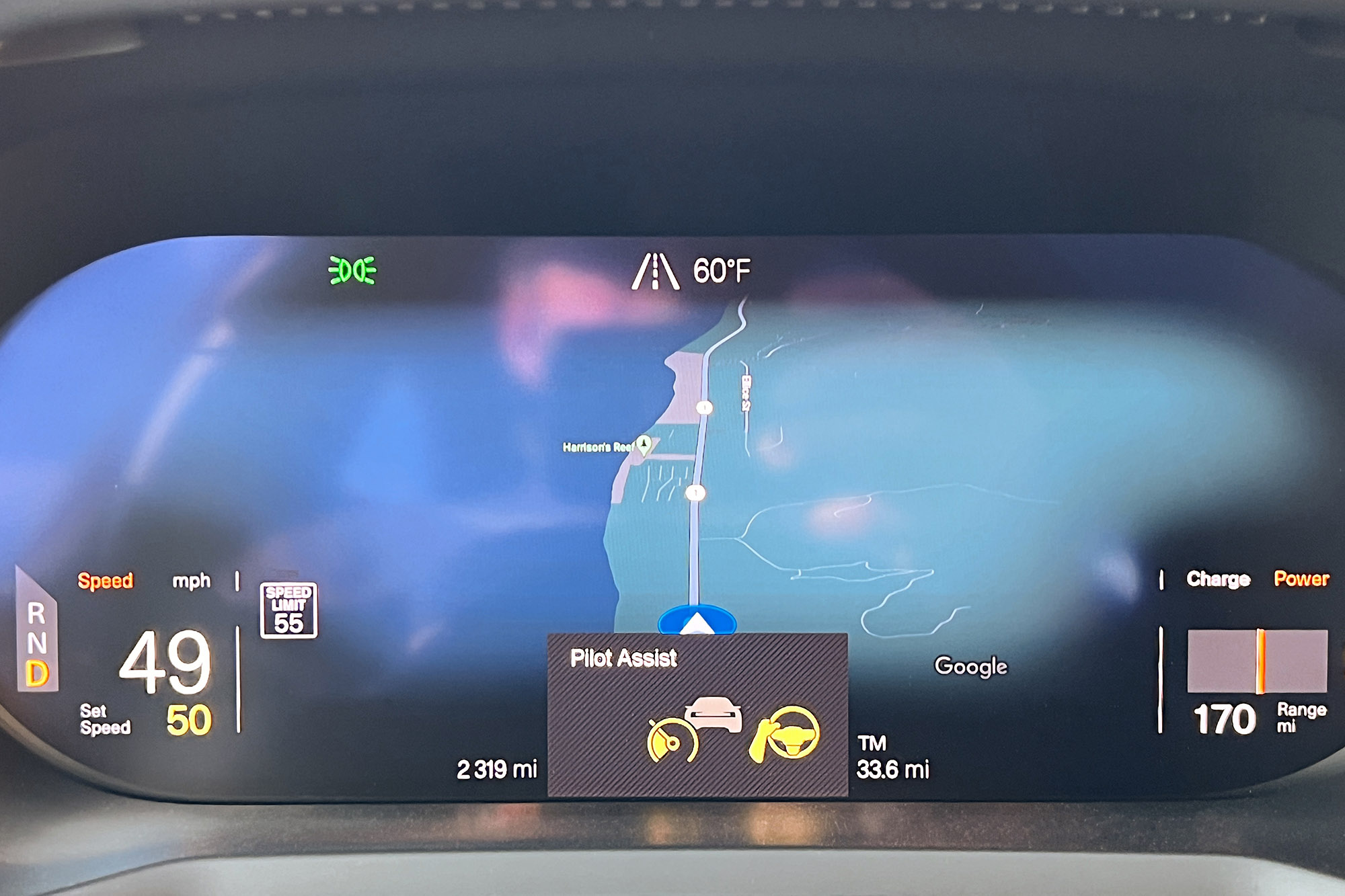 Christian Wardlaw
Christian Wardlaw
2024 Polestar 2 Pilot Assist: Steering You the Wrong Way
The Polestar 2's new front Smart Zone panel houses the car's forward-facing camera and midrange radar unit, which power many of its standard advanced driving-assistance systems. A Pilot Pack is optional, adding advanced driver-assistance systems such as adaptive cruise control, lane-centering assist, and emergency stop assist.
When using the adaptive cruise control and lane-centering assist together, Pilot Assist is active, providing a semi-autonomous driving-assistance technology that requires the driver to keep their hands on the steering wheel. If the technology detects an unresponsive driver, the emergency-stop-assist system will bring the Polestar to a safe halt.
Pilot Assist needs to be better. No matter what kind of road I traveled while using it, I struggled with the steering. But when I relaxed my grip and let the technology do its thing, it demanded that I hold the steering wheel — even though I already was.
In addition, it has a nasty tendency to add sudden, unwanted, and inaccurate steering input. For example, while traveling on Pacific Coast Highway north from Malibu, on a section where two travel lanes merged into one, Pilot Assist suddenly veered to the right for no discernible reason.
Later, on a stretch of PCH that looks like most interstates across the country, Pilot Assist tried to steer me off onto nearly every exit ramp. Then, when I signaled and took one of those exits, it wanted to steer me back onto PCH.
Based on my experience, Pilot Assist is challenging to trust. After I finished my evaluation, I turned it off, and the car was much more enjoyable — and seemingly safer — to drive.
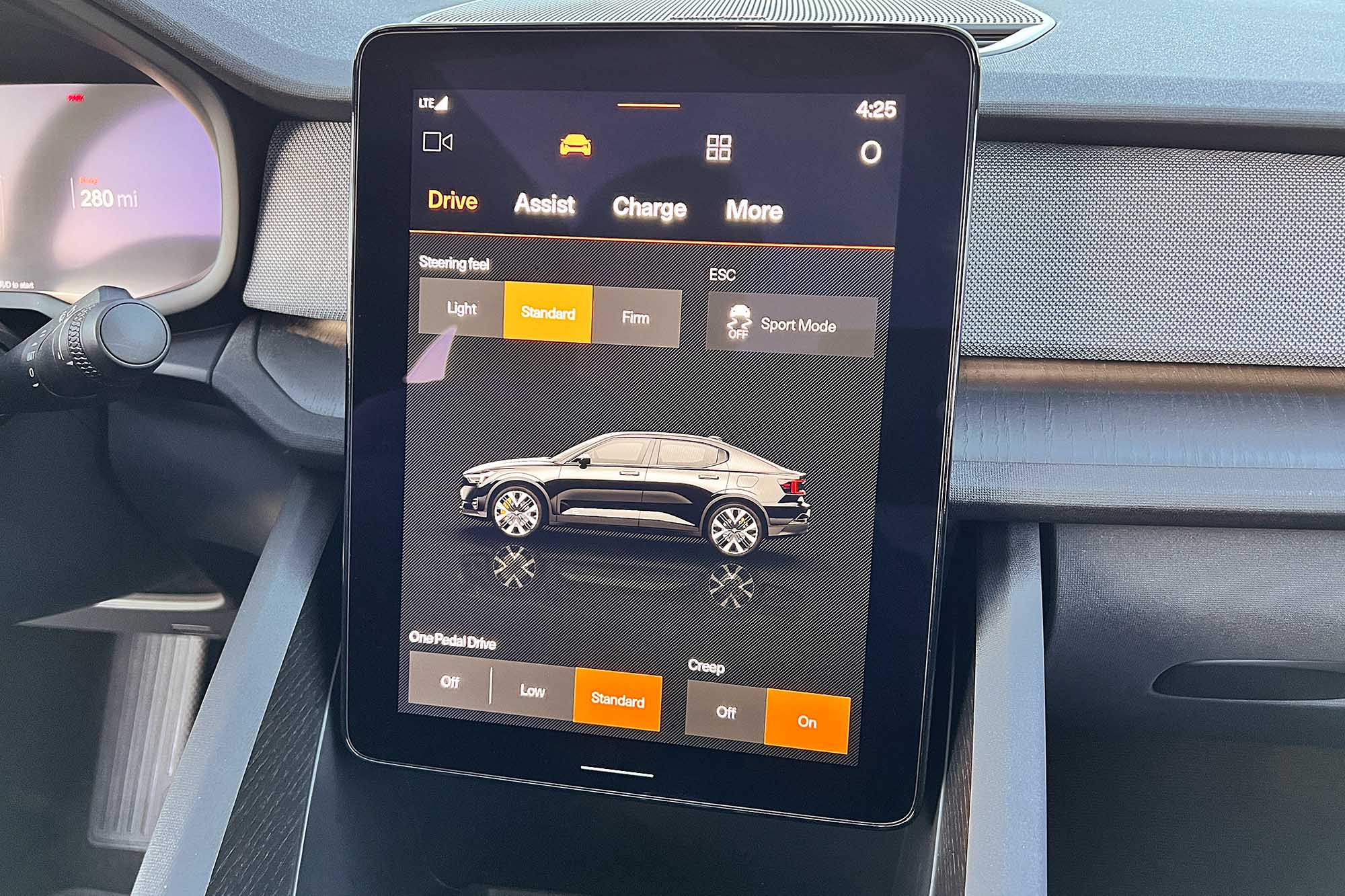 Christian Wardlaw
Christian Wardlaw
More Power, Efficiency, and Range
This year, the 2024 Polestar 2 gets new electric motors, more powerful and efficient batteries, and improved range estimates. In addition, the single-motor drive system benefits from faster recharging times, and this version of the car is now rear-wheel drive instead of front-wheel drive. The dual-motor drive system adds a rear-drive power bias for 2024.
My test car had the single-motor layout, with a 220-kW electric motor — 299 horsepower, 361 pound-feet of torque — powering the rear wheels. Polestar claims it can accelerate the car to 60 mph in 5.9 seconds.
An 82-kWh lithium-ion battery provides an estimated 320 miles of driving range. Using a DC fast charger delivering 205 kW of energy, you can recharge the battery from 10% to 80% in 28 minutes. Install an 11-kW 240-volt/48-amp charging station at home, and you can fully recharge the car in eight hours.
You can adjust several driving settings through the infotainment system. For example, you can set the steering effort level, calibrate the One-Pedal Drive function, and decide if you want the Creep mode on or off.
Creep mode has nothing to do with being creepy. Instead, it governs whether the car creeps forward when you release your foot from the brake pedal. Note that when Creep mode is on, the One-Pedal Drive system won't bring the Polestar 2 to a complete stop.
 Christian Wardlaw
Christian Wardlaw
Get In and Go
When you enter a Polestar 2, the car is already on and ready to drive. Arrive at your destination, exit the vehicle, and it shuts off. I personally don't like this because I prefer to activate and deactivate the drive system manually.
In city driving, the Polestar 2 is easy to operate. From a stop, acceleration builds as speed gathers rather than immediately providing a big punch of torque. In addition, the One-Pedal Drive system features well-calibrated progressive braking. Let up on the accelerator pedal and the slowing is subtle at first but gets stronger the longer you let the tech do its thing.
Traveling at higher speeds on a mountain road, the Polestar 2 exhibited a firm, almost choppy ride quality. In bends, occasional sudden lateral movements were evident when traveling over uneven pavement. You definitely feel the road surface and how the car reacts to it.
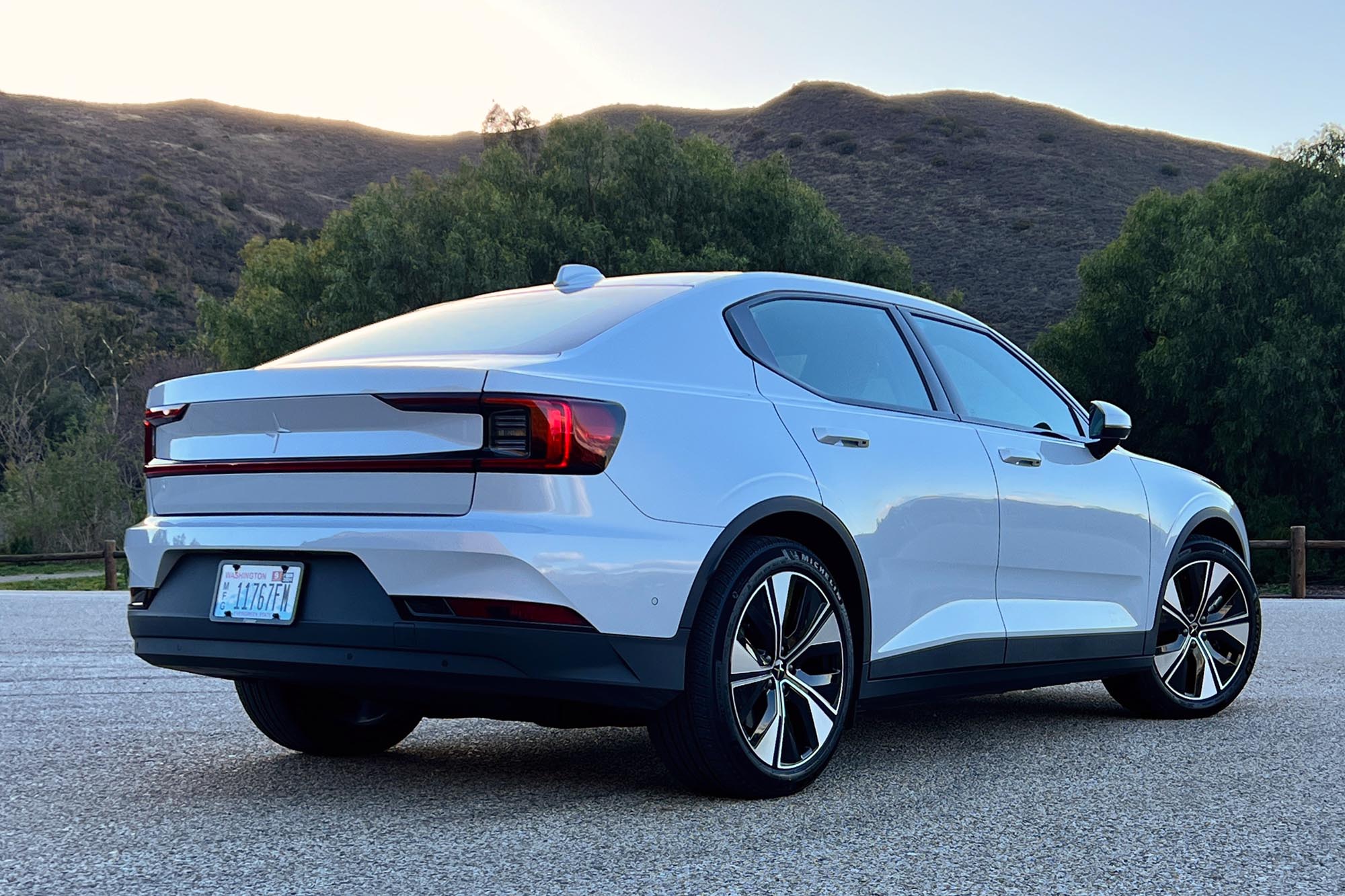 Christian Wardlaw
Christian Wardlaw
On a twistier stretch, the Polestar 2 demonstrated a flat cornering attitude, good grip, and predictable handling traits. You must use the brake pedal in this environment because the One-Pedal Drive system isn't aggressive enough to scrub speed before curves. The pedal feel is decent, but the steering wheel doesn't convey anything to the driver's palms. You can hustle a Polestar 2 confidently, but outright fun isn't part of the equation.
Highway driving is uneventful, though road noise was louder than I expected. Midrange passing power is robust, and the Polestar 2 is a pleasure to use for slicing and dicing through moderate traffic.
As for efficiency, my test car averaged 27.4 kWh per 100 miles of driving, beating the EPA estimate of 29 kWh per 100 miles.
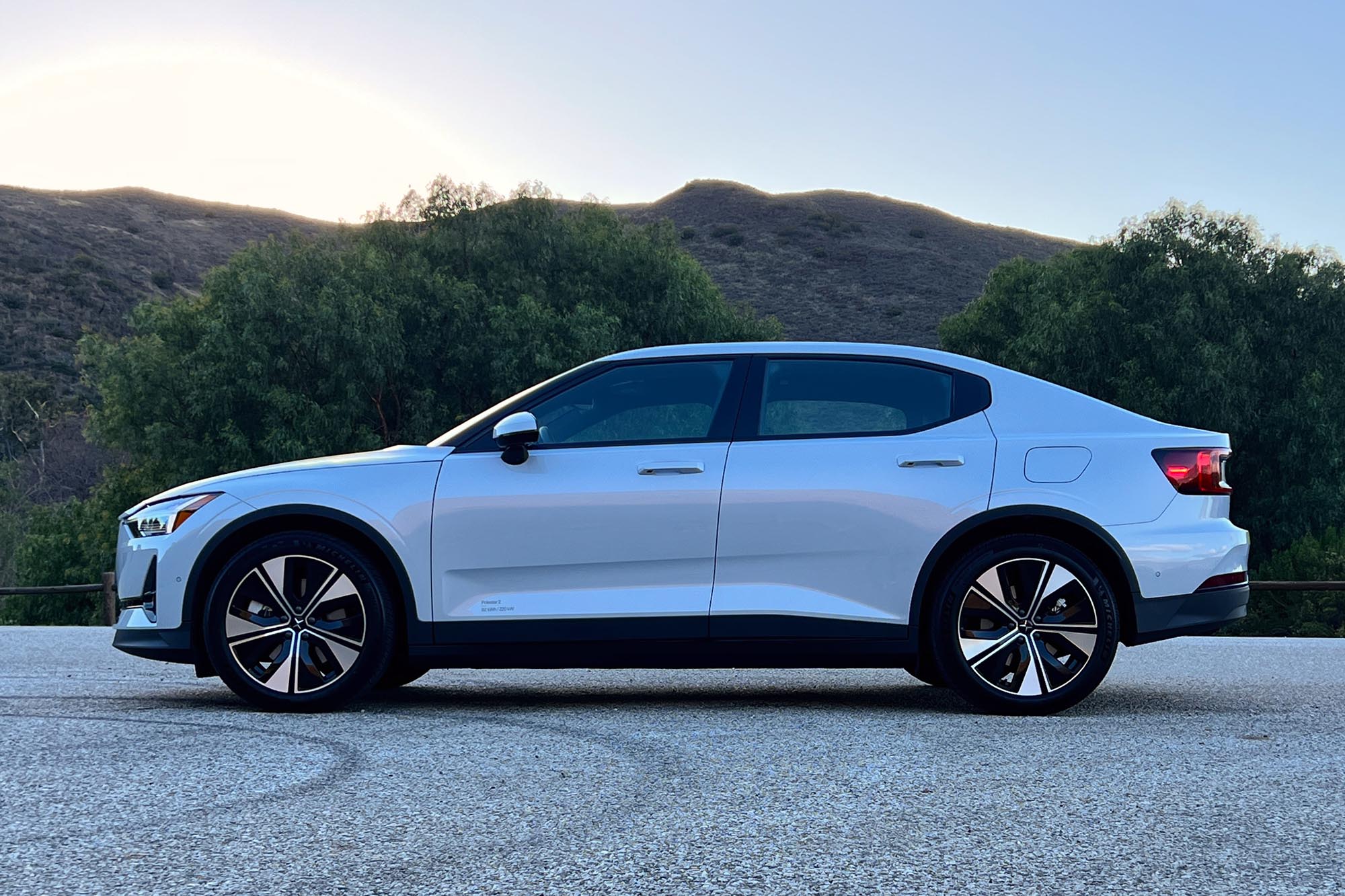 Christian Wardlaw
Christian Wardlaw
Polestar Faces Competitive Headwinds From Here on Out
Compared with its primary rival, the BMW i4, the Polestar 2 offers a competitive price. But EVs such as the Ford Mustang Mach-E, Hyundai Ioniq 5, Kia EV6, and Tesla Model Y are equally or more appealing alternatives. And even more electrics are on the way.
The updates to the likable 2024 Polestar 2 keep it competitive, but the road to EV success increasingly resembles your grandparents' trek to school: uphill, both ways, in deep snow.
Fortunately, given the automaker's Sweden-based headquarters, Polestar should know something about charging ahead in adverse conditions.
Written by humans.
Edited by humans.
 Christian Wardlaw
Christian WardlawChris says his first word was "car." For as long as he can remember, he's been obsessed with them. The design. The engineering. The performance. And the purpose. He is a car enthusiast who loves to drive, but is most passionate about the cars, trucks, and SUVs that people actually buy. He began his career as the editor-in-chief of Edmunds.com in the 1990s, and for more than 30 years has created automotive content for CarGurus, J.D. Power, Kelley Blue Book, the New York Daily News, and others. Chris owns Speedy Daddy Media, has been contributing to Capital One Auto Navigator since 2019, and lives in California with his wife, kids, dog, and 2004 Mazdaspeed Miata.
Related articles
View more related articles